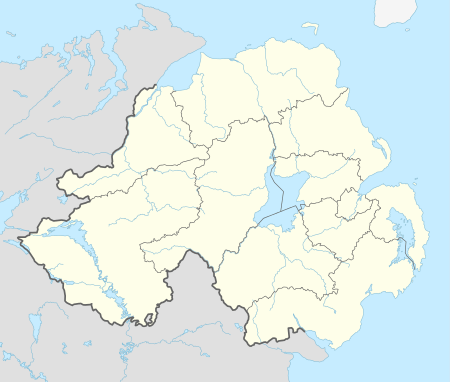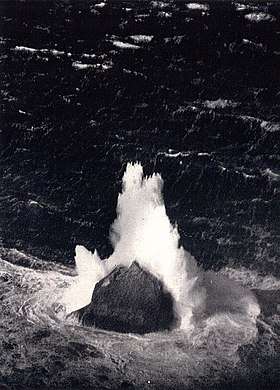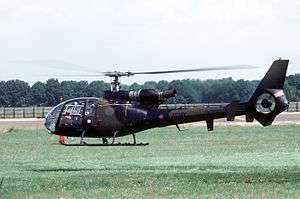Joint Helicopter Command Flying Station Aldergrove
Joint Helicopter Command Flying Station Aldergrove or more simply JHC FS Aldergrove is located 4.4 miles (7.1 km) south of Antrim, Northern Ireland and 18 miles (29 km) northwest of Belfast and adjoins Belfast International Airport. It is sometimes referred to simply as Aldergrove which is the name of a nearby village. The military flying units share the Aldergrove runways but have their own separate facilities and helipad.
| JHC FS Aldergrove | |||||||||
|---|---|---|---|---|---|---|---|---|---|
| Near Aldergrove, County Antrim in Northern Ireland | |||||||||
.jpg) Westland Gazelle AH1 of the type based at Aldergrove. | |||||||||
 JHC FS Aldergrove Location within Northern Ireland | |||||||||
| Coordinates | 54°38′58″N 006°13′31″W | ||||||||
| Type | Joint flying station | ||||||||
| Site information | |||||||||
| Owner | Ministry of Defence | ||||||||
| Operator | Royal Air Force (1918–2009) Joint Helicopter Command (2009–present) | ||||||||
| Site history | |||||||||
| Built | 1918 | ||||||||
| In use | 1918–present | ||||||||
| Airfield information | |||||||||
| Identifiers | ICAO: EGAA, WMO: 03917 | ||||||||
| Elevation | 69 metres (226 ft) AMSL | ||||||||
| |||||||||
| Airfield shared with Belfast International Airport | |||||||||
The site was formerly RAF Aldergrove, a Royal Air Force station which was in operation between 1918 and 2009.
History
Inter-war years
RAF Aldergrove first opened in 1918 but was not designated as an operational RAF station until 1925.
Various squadrons were posted here during this time:
- A detachment of No. 4 Squadron RAF between 30 April 1920 and 26 September 1922 again with the Bristol F2B.[1]
- No. 2 Squadron RAF initially at full strength between 2 June 1922 and 27 September 1922 and then as an detachment until 17 September 1923 flying the Bristol F2B Fighter.[2]
- No. 502 Squadron RAF was formed here on 15 May 1925 and used various aircraft types including Vickers Vimy's, Handley Page Hyderabad's, Virginia X's, Westland Wallace's, Hawker Hind's, Avro Anson I's, Blackburn Botha I's and Armstrong Whitworth Whitley V's until 27 January 1941.[3]
- A detachment of No. 214 Squadron RAF between 15 October 1935 and 1 October 1936 with the Virginia X.[4]
- No. 9 Squadron RAF between 15 January 1936 and 1 October 1936 initially flying the Vickers Virginia X until April 1936 when they started converting to the Handley Page Heyford III.[5]
- No. 85 Squadron RAF with the Hawker Hurricane I between 18 October 1938 and 4 November 1938.[6]
Second World War
Aldergrove's location made it an important station of RAF Coastal Command in the Battle of the Atlantic during the Second World War. From the base, long-range reconnaissance aircraft were able to patrol the Eastern Atlantic for U-boats. Some of these patrols ranged as far out as the distant islet of Rockall.

Various squadrons were posted here during this time:
- A detachment of No. 224 Squadron RAF between 1 September 1938 and 15 April 1941 with the Hudson I and III version's.[7]
- A detachment of No. 235 Squadron RAF with the Bristol Blenheim IVF between 24 June 1940 and 4 June 1941.
- No. 231 Squadron RAF between 1 July 1940 and 15 July 1940 with the Westland Lysander II.[8]
- No. 245 Squadron RAF with Hurricane I between 20 July 1940 and 14 July 1941.[9]
- No. 233 Squadron RAF between 3 August 1940 and 14 September 1940 with the Hudson I.[10]
- No. 102 Squadron RAF with the Whitley V between 1 September 1940 and 10 October 1940.[11]
- No. 272 Squadron RAF reformed here on 18 November 1940 with the Blenheim IVF and stayed until 3 April 1941.[12]
- No. 252 Squadron RAF between 6 April 1941 and 15 June 1941 with Beaufighter IC.[13]
- No. 254 Squadron RAF using Blenheim IVF between 29 May 1941 and 12 December 1941.[14]
- No. 143 Squadron RAF reformed here on 15 June 1941 with the Bristol Beaufighter IC, and stayed here until 24 March 1944.[15]
- A detachment of No. 48 Squadron RAF between 3 August 1941 and 20 October 1941 with the Lockheed Hudson V & III's.[16]
- No. 206 Squadron RAF between 12 August 1941 and 1 July 1942 using various versions of the Hudson including the I/II/III/IV and V.[17]
- No. 311 Squadron RAF between 28 April 1942 and 12 June 1942 with the Vickers Wellington IC.[18]
- A detachment of No. 120 Squadron RAF between 21 July 1942 and 24 March 1944 with the Liberator III.[15]
- No. 220 Squadron RAF with Boeing Fortress II between 14 February 1943 and 30 March 1943.[19]
- No. 86 Squadron RAF between 18 March 1943 and 6 September 1943 using the Liberator IIIA & V versions.[20]
- No. 59 Squadron RAF between 11 May 1943 and 15 September 1943 with the Consolidated Liberator V's.[21]
- A detachment of No. 547 Squadron RAF between 25 October 1943 and 13 June 1944 with Wellington XI and XIII's and Liberator V's.[22]
Post war
Aldergrove was designated as a dispersal airfield for the RAF's V bomber force in the 1950s and was included in a reduced list of 26 airfields in 1962. In 1968 No. 23 Maintenance Unit RAF was responsible for the maintenance of McDonnell Douglas F-4 Phantom IIs in RAF service, with 116 aircraft passing through on their way to front-line service. Aldergrove was also the main servicing and reconditioning station for the English Electric Canberra from their introduction in 1951. In 1976, the station had a staff of 2,500 RAF personnel and 1,500 civilians.[23]
Various squadrons were posted here between 1945 and 1985:
- No. 518 Squadron RAF operated the Halifax III, Hurricane IIC, Spitfire VII and Halifax VI between 18 September 1945 and 1 October 1946 when the squadron was disbanded here.[3]
- A detachment of No. 280 Squadron RAF between 3 November 1945 and 21 June 1946 when it was disbanded. It operated the Vickers Warwick I.[24]
- No. 502 Squadron RAF reformed here on 10 May 1946 and operated various aircraft types including de Havilland Mosquito B.25 & NF.30's, Supermarine Spitfire F.22's and de Havilland Vampire F.3's, FB.5's and FB.9's until 10 March 1957.[3]
- No. 202 Squadron RAF with the Halifax GR.6, A.9 and Met 1 version's from 1 October 1946 and 28 August 1964 when it was disbanded.[25]
- No. 214 Squadron RAF reformed here on 1 March 1948 and operated the Handley Page Halifax GR.6 until 18 October 1948.[4]
- No. 240 Squadron RAF reformed here on 1 May 1952 with the Avro Shackleton MR.1 and stayed until 27 May 1952.[26]
- A detachment of No. 275 Squadron RAF between 18 November 1954 and 1 September 1959 when it was disbanded. The detachment operated the Hiller HTE-2, Anson T.21, de Havilland Canada DHC-1 Chipmunk T.10, Sycamore HR.14, Westland Whirlwind HAR.4 & 2.[12]
- No. 1913 Light Liaison Flight of No. 651 Squadron RAF between 1 November 1955 and 4 April 1957 operated the Taylorcraft Auster AOP.6.[27] The flight was renamed 13 Flight No. 651 Squadron AAC on 1 September 1957 and stayed here until November 1952 when it was replaced by 2 Reconnaissance Flight, 2 Royal Tank Regiment.[28]
- No. 118 Squadron RAF reformed here on 1 September 1959 with Bristol Sycamore HR.14 before being disbanded here on 31 August 1962.[29]
Royal Air Force operations
No. 72 Squadron operated Westland Wessex HC.2 helicopters from Aldergrove from 12 November 1981[30] until its disbandment in 2002.[31]
No. 230 Squadron RAF was re-deployed from Germany to RAF Aldergrove in 1992, where it operated Westland Puma HC.1 helicopters until its relocation to RAF Benson in November 2009.[32]
No. 18 Squadron RAF also operated detachments of Boeing Chinook during the late 80s in support of the British Army in Northern Ireland.

- Army Air Squadron Operations
The 17/21st Lancers Air Squadron based at RAF Aldergrove from 1969 to 1971 operating with Sioux Helicopters and a Fixed Wing Beaver aircraft.
The following units were here at some point:[33]
- No. 1 Armament Practice Camp RAF
- No. 1 (Coastal) Engine Control Demonstration Unit RAF
- No. 1 (Coastal) Operational Training Unit RAF
- No. 2 Armament Training Camp RAF became No. 2 Armament Training Station RAF became No. 3 Air Observers School RAF became No. 3 Bombing & Gunnery School RAF
- No. 4 Coastal Patrol Flight RAF
- No. 5 Service Flying Training School RAF
- No. 9 (Coastal) OTU RAF
- No. 15 Group Communications Flight RAF
- No. 22 Air Crew Holding Unit RAF
- No. 23 Maintenance Unit RAF
- No. 61 Group RAF
- No. 67 Group Communications Flight RAF
- No. 67 (Northern Ireland Reserve) Group RAF
- No. 203 Gliding School RAF
- No. 226 Maintenance Unit RAF
- No. 278 Maintenance Unit RAF
- No. 402 Meteorological Flight RAF became No. 1402 (Meteorological) Flight RAF
- No. 405 Meteorological Flight RAF became No. 1405 (Meteorological) Flight RAF then absorbed by No. 1402 Met Flight in 1942.
- No. 651 Squadron AAC
- No. 655 Squadron AAC
- No. 665 Squadron AAC
- No. 671 Gliding School RAF
- No. 1361 (Meteorological) Flight RAF absorbed by No. 521 Squadron RAF
- No. 1362 (Meteorological) Flight RAF
- No. 1363 (Meteorological) Flight RAF
- No. 1364 (Meteorological) Flight RAF
- No. 1674 Heavy Conversion Unit RAF
- No. 2707 Squadron RAF Regiment
- No. 2850 Squadron RAF Regiment
- HQ RAF Northern Ireland
- Queens University Air Squadron
Army Air Corps operations
The Army Air Corps also operated Westland Lynx and Westland Gazelle helicopters as well as de Havilland Canada DHC-2 Beaver aircraft in its joint operations with the RAF's Reconnaissance Intelligence Centre (Northern Ireland); the Beaver was replaced by the Britten-Norman Islander late in 1988.
During 1991, No. 655 Squadron AAC moved from RAF Ballykelly to Aldergrove with the Westland Lynx AH Mk 7 helicopter.[28]
On 1 October 1993, the Northern Ireland Regiment Army Air Corps was retitled 5 Regiment Army Air Corps.[28]
On 4 August 2008, 651 Squadron Army Air Corps moved back to Northern Ireland from RAF Odiham almost 50 years after its first deployment there.[28]
Post Operation BANNER
During the latter years of Operation BANNER, 5 Regiment Army Air Corps and 230 Squadron RAF came under the control of the Joint Helicopter Command (JHC) and formed the Joint Helicopter Force Northern Ireland (JHF(NI)). As the site was no longer a major RAF establishment it became Joint Helicopter Command Flying Station Aldergrove.
After the end of Operation BANNER, a number of other Army units were relocated to Aldergrove. The base was no longer therefore administered by the JHC and became 38 Brigade Flying Station Aldergrove.
5 Regiment Army Air Corps continues to operate at Aldergrove, providing Gazelle, Defender and Islander aircraft in support of the Police Service of Northern Ireland (PSNI) and military units for Operation Helvetic, and for other operations abroad.[34]
Due to the closure of RAF Machrihanish, the base is now used for University Air Squadron and Air Training Corps cadets as a training camp, where cadets from Scotland and Northern Ireland Region gather for flying experiences, fieldcraft, shooting, first aid and other activities.
During 2003 Air Force One arrived at the airport in support of U.S. Presidential visits to Northern Ireland.
Aldergrove officially ceased to be an RAF Station on 20 September 2009 when, after the annual Battle of Britain parade, the RAF ensign was lowered for the last time and the Joint Helicopter Command flag was hoisted in its place.[35]
Based units

Units based at Aldergrove:
British Army
Joint Helicopter Command / Army Air Corps
- 5 Regiment
- No. 665 Squadron – Westland Gazelle AH1[36]
- Reconnaissance, Intelligence and Geographic Centre (Northern Ireland)(RIGC)[37]
Royal Air Force
- No. 502 (Ulster) Squadron (Royal Auxiliary Air Force)[38]
- Northern Ireland Universities Air Squadron – Grob Tutor T1[39]
- No. 13 Air Experience Flight - Grob Tutor T1
- No. 1 Group
- No. 651 Squadron Army Air Corps/Royal Air Force personnel – Britten-Norman Defender AL2/3 and Britten-Norman Islander AL1[40][41][42]
Civilian
- Police Service of Northern Ireland Air Support Unit
Citations
- Jefford 1988, p. 24.
- Jefford 1988, p. 23.
- Jefford 1988, p. 95.
- Jefford 1988, p. 71.
- Jefford 1988, p. 27.
- Jefford 1988, p. 50.
- Jefford 1988, p. 73.
- Jefford 1988, p. 74.
- Jefford 1988, p. 77.
- Jefford 1988, p. 75.
- Jefford 1988, p. 54.
- Jefford 1988, p. 82.
- Jefford 1988, p. 78.
- Jefford 1988, p. 79.
- Jefford 1988, p. 58.
- Jefford 1988, p. 41.
- Jefford 1988, p. 69.
- Jefford 1988, p. 85.
- Jefford 1988, p. 72.
- Jefford 1988, p. 51.
- Jefford 1988, p. 44.
- Jefford 1988, p. 97.
- Northern Ireland Committee of Irish Congress of Trade Unions, "The Defence Stations in Northern Ireland: The Case for Retention", March 1976
- Jefford 1988, p. 83.
- Jefford 1988, p. 68.
- Jefford 1988, p. 76.
- Jefford 1988, p. 102.
- "5 Regiment Army Air Corps". British Army. Archived from the original on 2 October 2015.
- Jefford 1988, p. 57.
- Jefford 1988, p. 47.
- "72(R) Squadron - Key Dates". RAF. Retrieved 7 November 2014.
- "230 Squadron". RAF. Retrieved 7 November 2014.
- "Aldergrove (Belfast) (Crumlin)". Airfields of Britain Conservation Trust. Retrieved 1 June 2016.
- "Operation HELVETIC - Joint Helicopter Force Northern Ireland (JHF(NI))". National Archives - RAF. Archived from the original on 8 November 2012. Retrieved 7 November 2014.
- Lowering of RAF Ensign Archived 6 June 2011 at the Wayback Machine RAF Website]
- "665 Squadron Army Air Corps". British Army. Archived from the original on 2 October 2015. Retrieved 23 February 2020.
- Merritt, Flt Lt; Wright, Flt Lt. "A Brief History and Update for the Reconnaissance Intelligence and Geographic Centre (Northern Ireland)". The Institution of Royal Engineers. Retrieved 27 February 2020.
- "502 Squadron RAuxAF". Royal Air Force. Retrieved 27 February 2020.
- "Northern Ireland Universities' Air Squadron (NIUAS)". Royal Air Force. Retrieved 27 February 2020.
- Jennings, Gareth (2 April 2019). "UK transfers Defender and Islander special mission aircraft from AAC to RAF". Jane's Defence Weekly. Retrieved 23 February 2020.
- Air Vice Marshal Harvey Smyth Air Officer Commanding No. 1 Group [@@HarvSmyth] (2 April 2019). "Handover of Fixed Wing Manned Aerial Surveillance from Army to RAF" (Tweet) – via Twitter.
- "651 Squadron Army Air Corps". British Army. Archived from the original on 4 June 2017.
- "Air Support Unit". Police Service of Northern Ireland. Retrieved 27 February 2020.
- "PSNI – Air Support Unit EC-145". Flying In Ireland Magazine. September 2010. Archived from the original on 13 November 2014.
References
- Docherty, Tom. Ours to Hold: RAF Aldergrove at War, 1939–1945. Cowbit, Spalding, Lincolnshire, UK: Old Forge Publishing, 2008. ISBN 978-1-906183-03-5.
- Jefford, C G (1988). RAF Squadrons. A comprehensive record of the movement and equipment of all RAF squadrons and their antecedents since 1912. Shrewsbury: Airlife. ISBN 1-85310-053-6.
| Wikimedia Commons has media related to RAF Aldergrove. |
